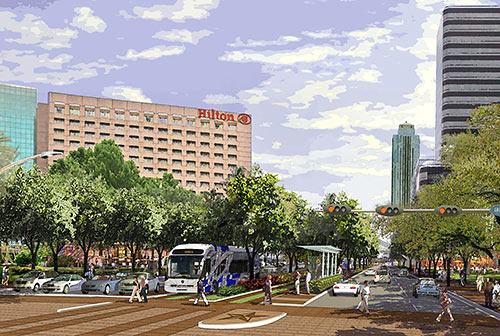
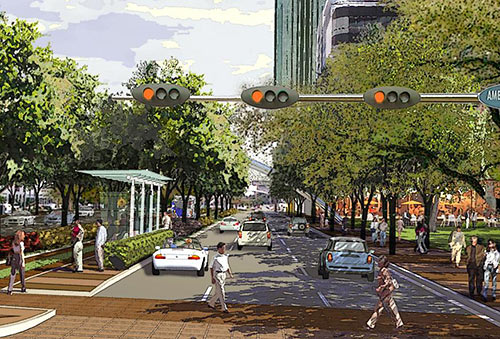
Here are some of the purty watercolor renderings the Uptown District has been presenting of what Post Oak Blvd. will look like after the addition of 2 dedicated bus lanes down its middle. The proposed changes to the thoroughfare won’t take away any of the 6 existing car lanes or 13 existing left-turn-signal lanes. There’ll be a few modifications, though: new protected-left-turn signals will be put in at West Briar Lane and Fairdale, for example, and 3 median openings will be closed. The space for the buses and 8 transit stations along the Boulevard between the West Loop and Richmond Ave will come from acquiring 8 feet of right-of-way from each side of the existing street. The bus lanes and light-rail-style stations will go in the median:
***
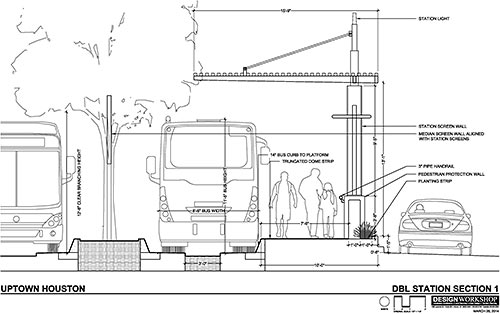
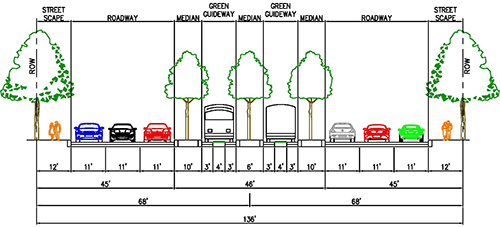
Notably, the Uptown District presentations never use the phrase “Bus Rapid Transit,” or BRT in describing the upgrades, though a BRT system has been pitched as a replacement for Metro’s earlier proposal for an Uptown light-rail line. Uptown Houston got approval for a $61.8 million federal grant to fund the street reconstruction last year. It appears that the lanes will be used for commuter buses as well: “This joint project of the City of Houston and Uptown,” an executive summary of the program reads, “will develop a system designed to connect workers to Uptown via Houston’s highly successful HOV network.” The dedicated bus lanes are an additional piece of the project.
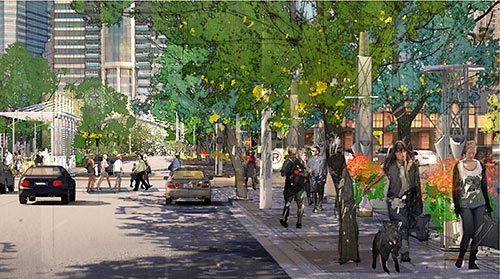
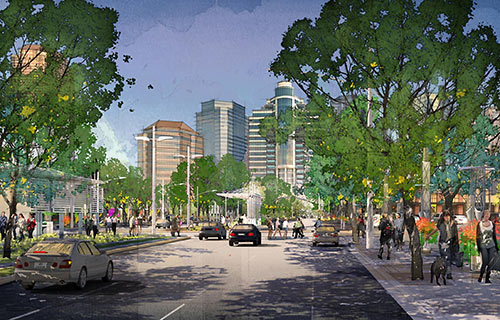

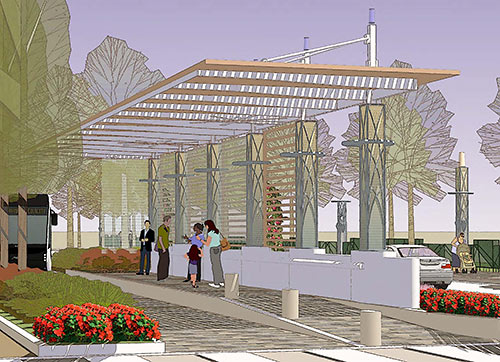
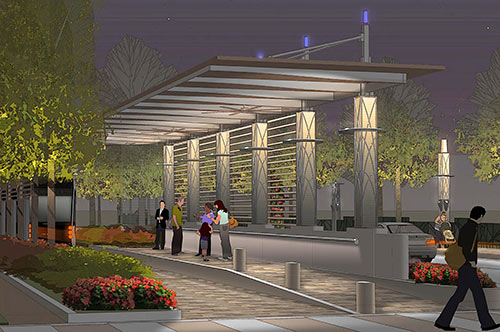
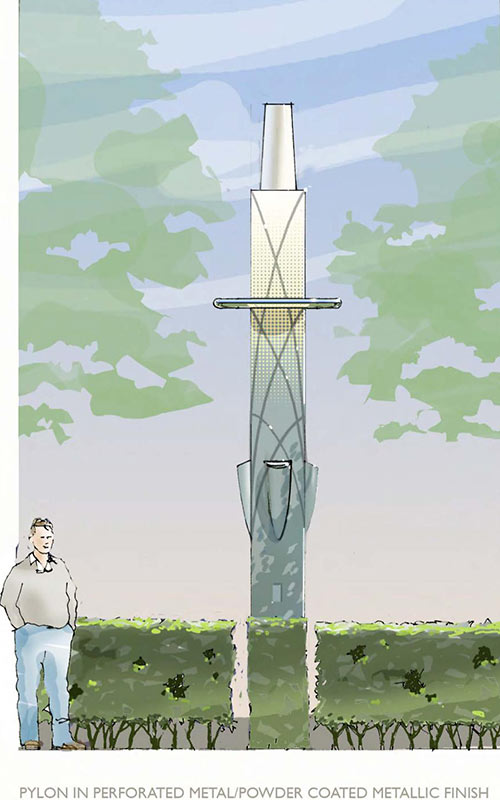
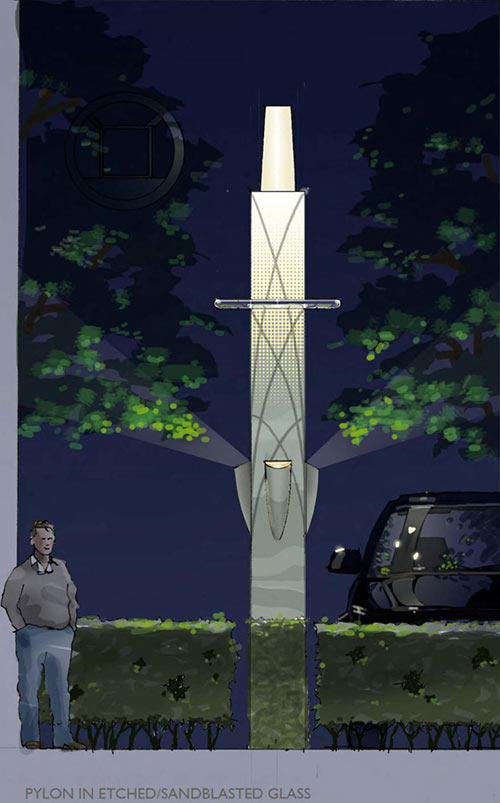
The program intends to preserve, relocate, or replant the existing median’s oak trees. Here’s a plan showing the stations along the route:
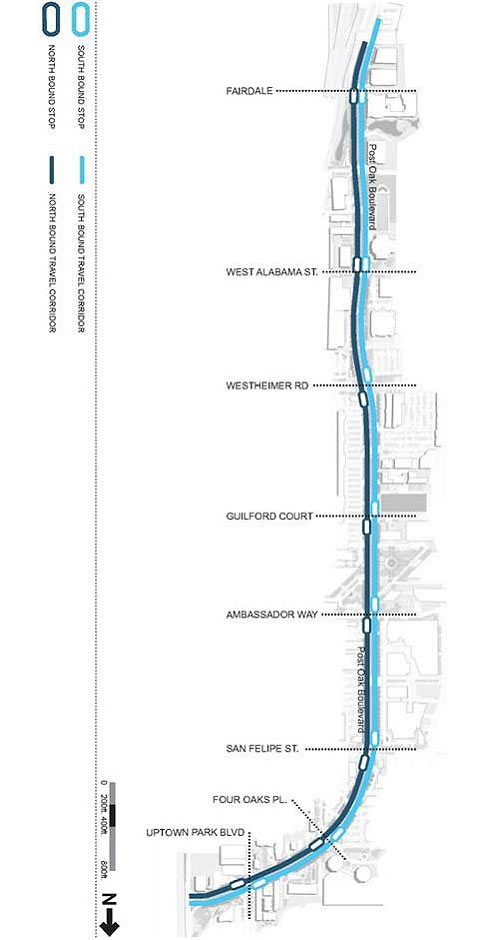
The buses will still have to stop at intersections, and move through lights only when cars do. “All travel time savings for the buses will be generated by simply being the ‘first-in-line’ at the signalized intersections made possible by the dedicated bus lanes,” the summary notes.
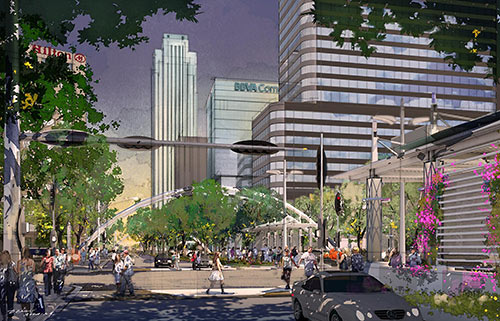
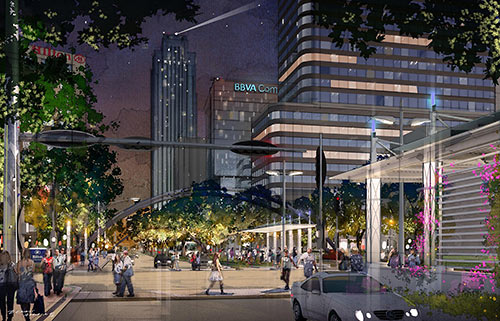
- Current Mobility Projects [Uptown Houston]
- Previously on Swamplot: Federal Money Rolls in for Uptown’s Post Oak BRT; Post Oak BRT That Much Closer to Getting Its Money; Funding the Post Oak BRT; Uptown’s Not Waiting for Light Rail, Planning Bus System Along Post Oak Instead
Images: Uptown Houston





“All travel time savings for the buses will be generated by simply being the ‘first-in-line’ at the signalized intersections made possible by the dedicated bus lanes,†the summary notes.
mind-boggling, so we’re throwing down gobs of money and buying up 16-ft of additional right of way all so that these buses can be ‘first-in-line’at signalized intersections? i mean, am i really just THAT dense and am missing out on other ways this wil help ease transportation times whether it be by car or bus?
anyone have the traffic data on this? why is not just adding 2 more lanes to the throughfare for both car/bus usage not a more effective way to increase transit times?
Awesome. Can’t wait for the new light rai – buses on Post Oak Blvd., and the pressure it will bring to run light rrrrrr – buses all the way down Richmond.
Looks like rail without rail. Would love to see this along the richmond corridor where rail could not get the political traction to be built.
The renderings are nice, but they’re showing a quarter the number of cars you’ll see on the road. The feel of the space is going to be very different when it’s gridlocked.
.
Don’t get me wrong. I think it’s a great idea to put true BRT down Post Oak. I’m just saying there’s a major inaccuracy in the renderings is all.
I must admit that I was a little skeptical when I first heard of this plan. But now that I see the drawings, I can see how this might actually work. But only if this “line” has a direct connect/transfer with the Metro commuter bus lines that utilize the I-10, US-59, and US-290 corridors. If it does, I can see this being an attractive way for a large number of Galleria area workers to commute.
This is a smart project. Having the commuter buses link into the BRT lanes is slick. Hopefully they’ll be able to convert the entire HOV/BRT into commuter rail/light rail at some point if the money is available, or maybe this will end up being loved and all that is needed and will spread throughout the city.
Joel, I believe it’s supposed to help due to ‘hopeful’ reduction in cars for people who just want to get from point to point along Post Oak. I don’t know who those people are, or if it would help in any way, but I think that’s the theory. A reduction in traffic problems due to busses stopping on the right most lane would also be good.
Adding a new lane on each side, with busses still weaving in and out and causing congestion in the right lanes would have the same issues as they have currently.
Looks nice. And, looking at the designated space and design it should be easy to upgrade it to light rail down the line.
Oh goody, Harrisburg gets light rail and Post Oak, buses–it’s actually hilarious. Hot shot young executives riding buses and maids and janitors riding light rail. Seriously, Culbertson really sucks as do all the Douchbags in Afton Oaks–thx, can’t wait to hop a bus on Post Oak as my housekeeper takes Metro light rail.
While I was first skeptical of the project, I think it will end up being a lot like the Denver 16th Street Mall, which is pretty awesome, effective, and popular.
Still have to stop at lights? That takes a lot of the advantage away but not having buses in traffic in that area will be nice. especially near the mall.
I am surprised that the Uptown powers that be would opt for such a low-class form of transportation in an otherwise upscale area. Get real …. get rail!
Uh… I think they left out a few hundred cars from that rendering. Traffic is already pretty crazy around at certain times of the day. Eliminating lanes and adding more–and longer–traffic lights, eliminating left turns (all of which you see up and down Main street where the light rail was first installed) without significantly reducing the number of vehicles on the road in that area will only create more frequent and more intense traffic (as it has along main street and the cross streets that have to deal with the light rail along it). Not to mention the cluster fuck that will ensue during construction.
The reality is that Houston is simply not a public transportation oriented city. Never has been. Never will be.
Look at those beautiful elevated busways that will run down the middle of 610. Page 6 of the PDF. Can’t wait to see trains on them someday (far in the future that day may be).
If they are increasing the Post Oak ROW by taking over 8′ on each side of the existing street, then those pretty live oaks lining the sidewalks in these pictures won’t look like that until around the year 2025. Since they will cut down the ones there now to build that extra traffic lane.
On another note, DART will have a light rail line opened by August of this year linking downtown Dallas to DFW Airport. IAH might get a light rail link about the time the trees in these renderings are full size.
Where’s the bicycle lane? Sarcastically saying…
The plan is going to take employees who drive to work from Katy and sugar land off the roads and allow them to park in transit lots outside of uptown and ride the buses in to the office buildings. That will decrease significantly the number of cars driving in and out of the area. It works very well for the medical center where they have instituted a similar plan with the rail. I’m sure employers will give employees the opportunity to participate To help negate the overcrowding. Two more lanes of cars wouldn’t help the situation at all.
Jared you didn’t read or comprehend the article. It is not taking lanes away. This system isn’t planned to make a quicker trip but to eliminate many of the cars into the area.
With far-side station placement at 14 of the 16 stations they really ought to consider signal priority for buses. Perhaps they will be smart enough to at least time the lights so the wait time is minimized. The perception of slow travel times will reduce potential ridership.
merp, thx for the response.
perhaps the buses weaving in and out of the open lanes really is just that much of a traffic mess, but as an engineer with a mind geared for efficiency it just worries me that the city is currently undergoing a massive renovation to add lanes on both suface streets and highways that are specifically designed to be underutilized. from an efficiency of public land utilization and economic perspective it still doesn’t make sense to me, but guess i’d have to familiarize myself with traffic analysis and such to really be up to speed. i’m sure plenty of engineers must have been running the analysis on this. when i think of all the commuter buses I’m just imagining this being beneficial during rush hour traffic and there alone, whereas more lanes to thoroughfare would help move traffic along at all times of the day/week.
and just remember all, at the end of day it wasn’t politics that crushed the rail on Richmond, it was economics. we don’t have the money and the right of way acquisitions are quite enormous from what i recall. still looking for confirmation that light rail on surface streets actually increases commuting times rather than just causing a lot more pollution due to massive road renovations and increased car idling at more intersections / detouring around restricted turns.
Dodging three lanes of traffic to get to the median will be a bit like the old Frogger game. Good luck, especially since people in that area turn right on red without ever looking for pedestrians. Unless they plan on dedicated crosswalks with all vehicular traffic stopped, I predict quite a few squashed frogs…
I do wish they would consider electric buses like that have in SF. It would reduce the noise/air pollution caused by all that bus traffic and maybe pay forward on some of the power needs if the line is ever converted to rail.
Dodging 3 traffic lanes is nothing. At least with it in the median you are essentially crossing a one way street. Much better than the crazy post oak of today
Sorry but those are not watercolors. Thats all done in photoshop and are digital renderings.
So – instead of the buses weaving in and out of traffic, we’ll have pedestrians trying to get TO the buses weaving in and out of traffic. And – NO bike lane?
Won’t it just be crazy with cars trying to turn left (say, going southbound on Post Oak into Container Store lot) trying to cross 2 bus lanes with obstructed vision from the bus stops and the pedestrians standing around?
I do hope they will not just chop down the current trees along each side but will move them instead when they expand the width of the street. Will the street widening also cut into surface parking lots? Ugh.
This will be a great piece of infrastructure for Uptown and Houston, and we as a community should be looking for more places in the urban core to deploy this setup.
I should note, however, that the premise that hooking Uptown into the HOV/HOT commuter bus system will somehow reduce congestion. There will be congestion with or without the exclusive bus lanes (what to call them if not BRT?). But that’s not the point – the point is to provide a significant capacity increase for the total number of people being able to reasonably access employers along the corridor during prime commute hours – an alternative to asking them to endure terrible slow congestion-filled commutes on US 290, IH 10 and US 59. A terrific way to support the Uptown office market, finally resurgent after 30 years of dormancy, in part because of the anticipation of this project.
It’s very expensive, but unquestionably a better use of the funds than just adding two more regular lanes to the Boulevard, which wouldn’t do much of anything to help people avoid congestion.
Hmmm, the stops going to have fans.
Planner nailed it.
When you look at the downtown traffic studies, the aggregate numbers and proportions of commuters that are able and willing to utilize METRO’s integrated P&R service and HOT/HOV system is profoundly impressive. (Suburban commuters actually commute by private cars less often than urban commuters; it’s that effective.) Without such good service, downtown would be mired in traffic, parking rates would be much higher, office rents would suffer, and freeways would congest even further to the extent that it would hurt the entire urban core and be a net benefit to suburban office submarkets that are harder to serve with transit. Consider then that these are the same problems that have historically held back Uptown and I think that it can be argued that this is a solution that, in full context, is probably superior to having light rail and a forced P&R transfer at the Northwest TC.
In time, and perhaps with some technological progress, I think that it will be recognized that similar projects are more beneficial to Houston’s urban core than is light rail investment.
Yeah, adding bike lanes would make it perfect. They’ll be making each sidewalk 12′ wide instead of the current 4′. They could go 6′ for the sidewalk and 6′ for bike lanes instead perhaps. Or maybe they decided that traffic is so slow there that bikes in traffic lanes are ok. And as for the trees , the plan, ” Preserves, relocates and replants Post Oak Boulevard’s Signature Oak Trees”.
Regarding sidewalk width and bike lanes – a 6-foot bike lane and 6-foot sidewalk would not work, because generally accepted best practice (and the design standard contained in the Transit Corridor Ordinance) requires maintaining a 6-foot “clear zone” path for pedestrians. That means a walkway with NO obstructions like trees (beneficial though they are), signs, utility fixtures, benches, etc. etc. If you constrict the total sidewalk width to 6 feet you obviously cannot meet this standard.
Bicycles can actually have pretty good access to most properties in the corridor via S Post Oak Lane / McCue and the smaller east-west streets that traverse the Boulevard – they may have to ride through some private driveways and parking lots on the east side of the Boulevard, but it certainly can be done.
And for everyone worried about pedestrians crossing the Boulevard to the stations: (1) It’s just 3 lanes. (2) There will be signals at each crossing for protected passage.
In fairness to Metro, this was probably the only way to get around Culbertson and all the Westside anti light rail sentiment. I hope this can easily be converted to light rail when Culbertson is gone. (the sooner the better)
It’s so congested on that strip of road that whenever a bus stops to pick up or drop off passengers, chaos ensues. You will never find a higher concentration of road-raged drivers than those waiting at the corner of Post Oak and Westheimer. Presumably it will alleviate some traffic, but that’s likely not really the goal. The congestion there is a permanent given, but you’re trying to get people from one point to the next, not cars. At the very least, you won’t have to get into your car to go from Dillards to DSW.
No, the BRT needs signal priority at least during peak hours. It only needs a green for a second or three at the most, and then the signals can resume as though the bus were never there.
It’s amazing how behind we arein Houston because of crap politicians.
As an almost daily visitor to the area for decades, this will not reduce traffic, it will actually increase it. The vast majority of cars that create the traffic are just passing through the area to get to the freeway or down Westheimer corridor. The buses that run there now are universally under utilized and despite popular belief there IS plenty of garage parking for all of the office building.
It isn’t supposed to reduce traffic. It’s supposed to provide an alternative to traffic. This is so employers can attract employees who have chosen to live in Cypress, Katy, Sugar Land, etc. and have become reluctant to commute to Uptown due to traffic congestion.
Parking isn’t as much of an issue, though some of the office buildings have been fielding requests from potential tenants who want much higher parking ratios than the garages were designed for. This will help mitigate that.
I don’t see why this would increase congestion, they’re keeping all the regular lanes; most of the signals were also being added anyway. If commuter bus service was being taken out of the regular lanes to be put into the exclusive lanes, wouldn’t most drivers be happy about that?
Finally, the service plan is for high-frequency service to link to the high-frequency park and ride buses. Such service as it exists now is much lower frequency with limited duration of service. Increasing frequency and duration should have a significant positive effect on the number of people who would feel that park and ride from the outer suburbs would be a reasonable option.
This will also kill some of the taxi traffic from the hotels since vistors to the area will probably choose the bus to get to local attractions
It’s great to see renderings of this project. It’s not just a vision, but it’s funded and going to be built.
If I am correct, this route could be upgraded to rail in the future. This is a great idea, but when it’s time to upgrade how difficult is it going to be to build the light rail infrastructure? Construction on the new light rail seemingly is crawling at a snail’s pace (typical of construction). Upgrading the Uptown line would shut the bus line for months, maybe a year or two.
Regardless, traffic will be a little better on this route. Some drivers will be taken off the road, and more importantly sluggish Metro buses will be in their own lane. Have you ever driven behind a Metro bus on the right lane?
Well, if this contributes in a way to building new office space somehow, then I guess that counts as increasing, not decreasing congestion.
Developement will continue at a torrid pace whether this thing is built or not–it’s a major disappointment compared to light rail, however if it’s built in a way that can easily be converted to light rail it’s a brilliant move by Metro to get around the Culbertson gang and their protracted ground war against light rail on the Westside.
It’s a shame they didn’t do like San Antonio and do a modern street car, it would have looked exponentially better than buses. I will say Metro is light years ahead of Via in terms of light rail, San Antonio has zero light rail which is amazing for a city with so many working class people who rely on Via as their only transportation, it’s a real failures by the brass at Via and the shortsighted Bexar County voters–you think Harris County is hostile to light rail, you should see Bexar!
Does anyone have the names of the three or four people who have a need to get from one spot on Post Oak to another? Do they know that their travel necessities have been valued at something like $15 million each?
Lovely. We’re gonna have MORE accidents with pedestrians,cyclists,drivers,et al .The short sighted,cheap minded idiots @ METRO once again are taking the crappy short cut to ” mass transit solutions ” in the Houston area. ELEVATE the fricking thing,for crying out loud. The dunderheads at METRO do not (except for photo ops) ride METRO. They’re lame brains. For the best example: see all of the news stories of the numerous accidents along the Main St. corridor. And whoever decided to reduce the number of lanes should be tied to the front of METRO rail cars with a camera and experience the excitement of an oncoming crash !!!!